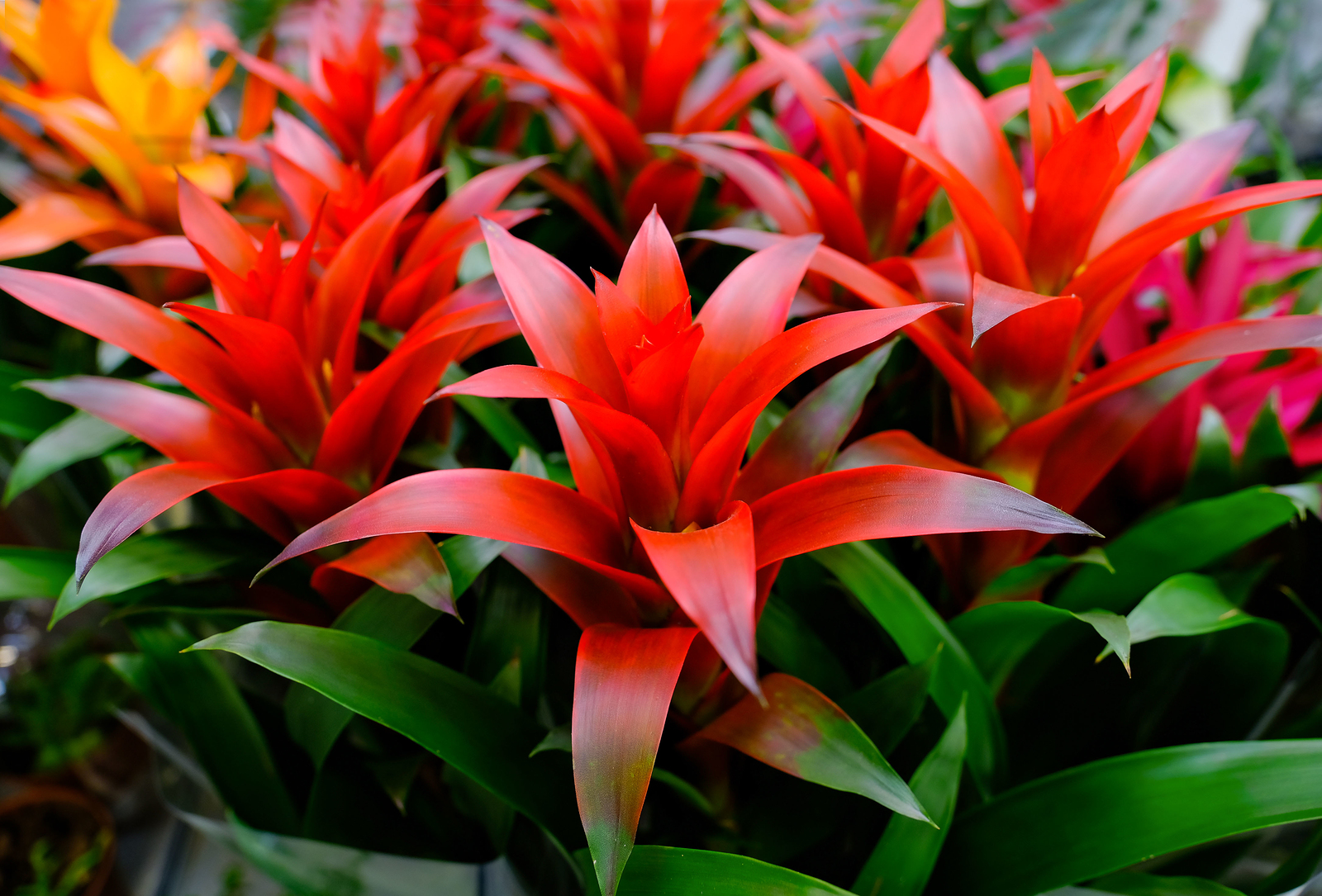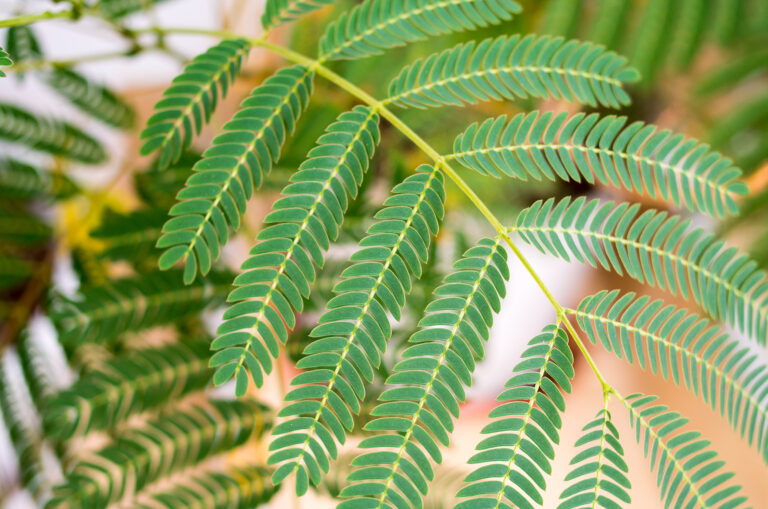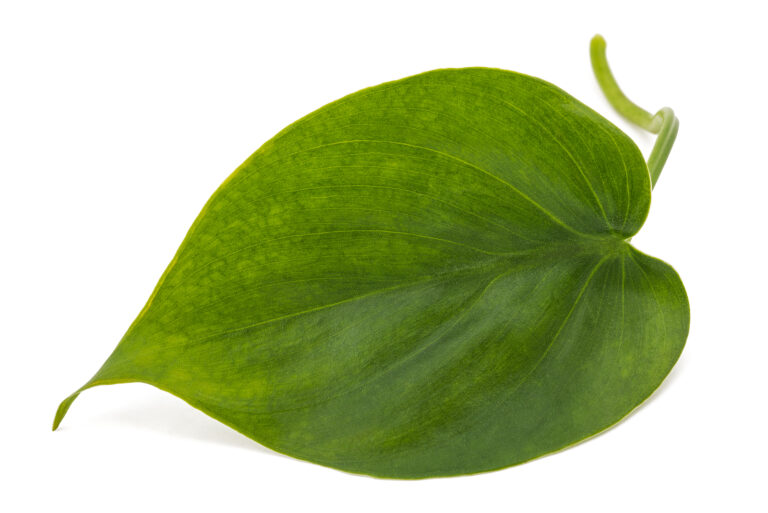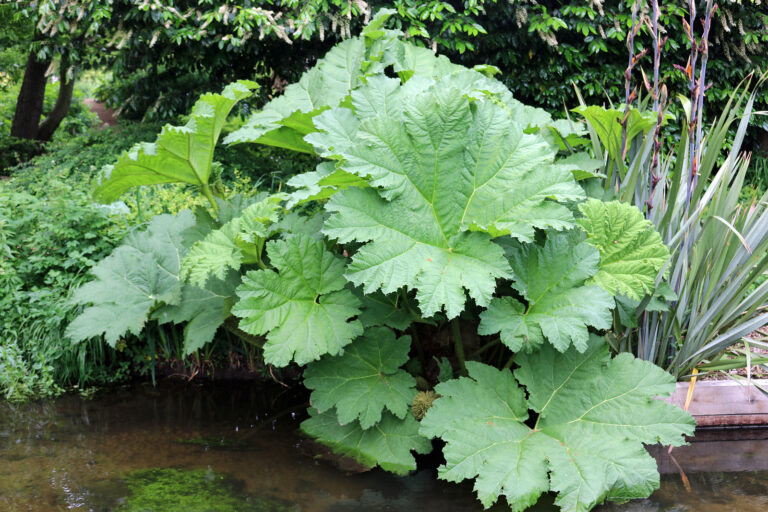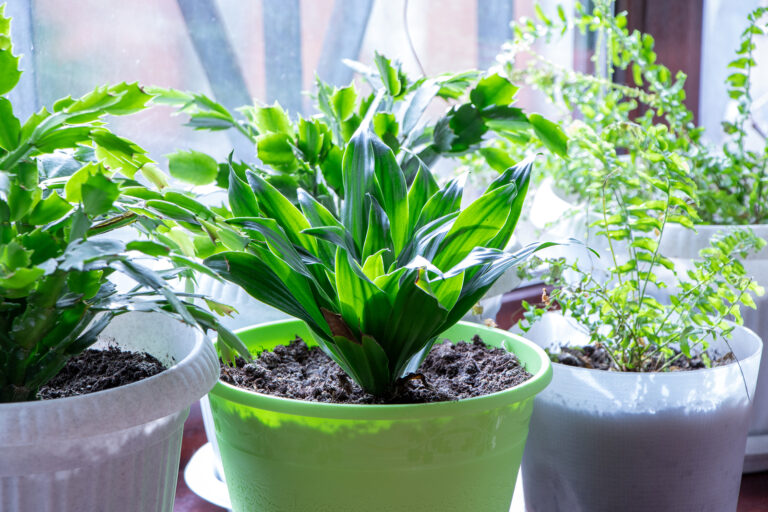How to Grow Bromeliads
Bromeliads are a family of tropical and subtropical plants known for their striking foliage and vibrant, long-lasting flowers. They are epiphytic or terrestrial, meaning they can grow on other plants or directly in soil, respectively. Bromeliads are low-maintenance, drought-tolerant, and can thrive in a variety of environments, making them ideal for both garden use and as houseplants.
Generally, bromelia have long stiff leaves with spines along the margins; leaves are set in basal rosettes. Flower stems can rise to several feet high and are crowned with spikes or dense flat heads of bloom.
Bromeliads are tropical and semi-tropical plants that must stay warm—about 75°F (24°C). They grow and flower best when the air is humid.
See a list and description of the most popular Bromeliads below with links to growing tips for each.
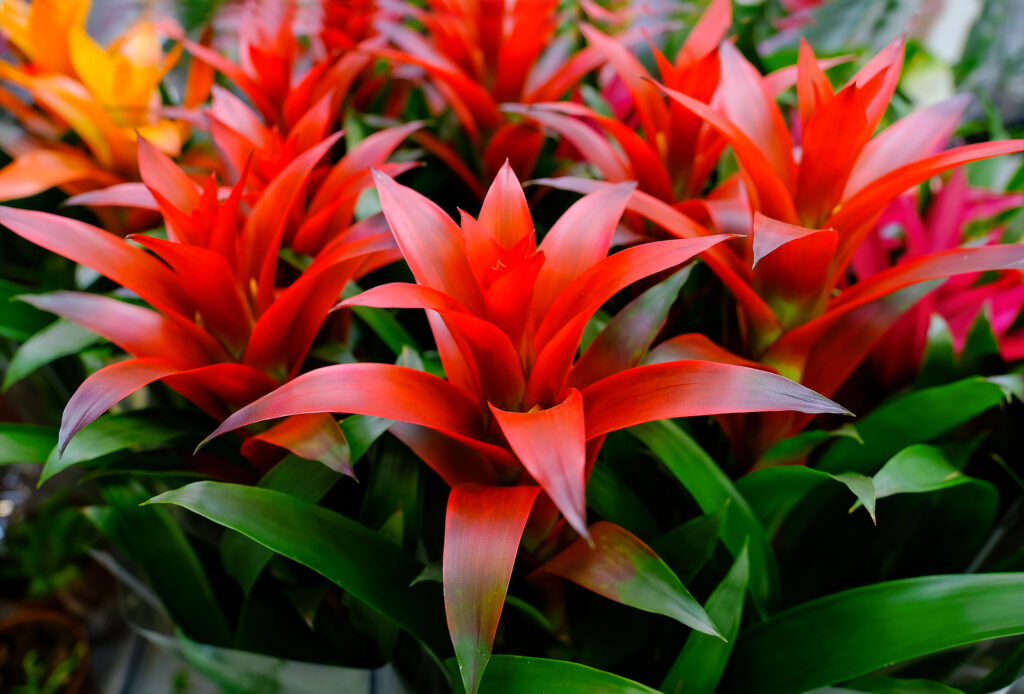
Characteristics of Bromeliads
- Foliage: Their leaves form a rosette shape, often with a central “cup” that collects water. The leaves can range from solid green to variegated with red, purple, or yellow hues.
- Flowers: Bromeliad blooms are stunning, colorful, and long-lasting, with shades of red, pink, orange, yellow, or purple. The flower stalk typically emerges from the center of the rosette.
- Roots: Epiphytic bromeliads have minimal root systems that serve mainly for anchoring rather than nutrient absorption, which happens through the leaves.
Using Bromeliads in the garden
- Garden Design: Bromeliads add an exotic and tropical flair to outdoor gardens. They can be used in garden beds, as accents in rock gardens, or tucked into nooks on tree trunks and branches for a natural, epiphytic look.
- Partial Shade: While they love bright light, most bromeliads prefer indirect sunlight or partial shade, making them perfect for shaded garden areas or under trees.
- Low-Maintenance Beds: Plant them in well-drained soil. Once established, bromeliads need little water, making them a good choice for low-maintenance, drought-tolerant gardens.
- Container Gardening: They grow well in pots, allowing flexibility in arranging them around patios, porches, or outdoor seating areas.

Using Bromeliads as houseplants
- Indoor Decor: Bromeliads are popular houseplants because of their bold foliage and colorful flowers. They can be placed on tables, shelves, or as floor plants to add a tropical touch indoors.
- Light: Place them in bright, indirect light (such as near windows). Too much direct sun can scorch their leaves, while too little light may prevent flowering.
- Watering: Fill the central cup with water and change it regularly to prevent stagnation. Mist the leaves occasionally and water the soil lightly if the plant is in a pot.
- Humidity: Bromeliads thrive in humid conditions, so they’re well-suited to bathrooms or kitchens. Alternatively, you can use a humidifier or mist the plants to mimic their natural environment.
- Low Maintenance: They don’t require much fertilizer and can thrive even in low-nutrient conditions. Use a balanced, diluted fertilizer once a month during the growing season.
Tips for Bromeliad care
- Drainage: Whether indoors or outdoors, ensure that bromeliads are planted in a well-drained medium. Standing water can lead to root rot.
- Temperature: Bromeliads prefer warm temperatures, ideally between 60-80°F (15-27°C). Keep them away from cold drafts indoors.
- Propagation: After flowering, bromeliads produce “pups” or offsets around the base. These can be separated and replanted to grow new plants.
Get to know Bromeliads
- Plant type: Tropical perennial epiphytic or so-called air plants
- Growing Zones and range: 10-11; will grow outdoors in Zone 9 with protection
- Temperature: Bromeliads need consistent warmth, 75°F (24°C) is best, not less than 60°F (16°C)
- Height and width: Vary by variety; commonly 6 inches to 24 inches tall
- Foliage: Rosettes of stiff leaves range from 1 inch to 3 feet (90cm) tall; most bromeliads have natural vase forms of a tight rosette of leaves
- Flowers: Showy spikes of red, yellow, pink, and green
- Uses: Houseplants; grow outdoors in semi-tropical regions
- Botanical name: Various genera—see below for descriptions
- Common name: Bromeliads, air plants, living vase plant
Where to plant Bromeliads
- Bromeliads need bright light, but not direct sunlight.
- Bromeliads are epiphytic—so-called air plants; they do not need soil to grow. In nature, they use trees, rocks, and other plants to support their tiny root systems
- Most bromeliads grow best in clay pots and an epiphytic wood chip mix—an orchid potting mix; these mixes are fast draining.
How to water and feed Bromeliads
- Keep the center of cups of vase-shaped types filled with rainwater; drain and refill the cups every week or two. Let other types dry between watering. Provide extra humidity.
- Fertilize bromeliads with liquid fertilizer twice a month in spring and summer and once a month during the rest of the year.
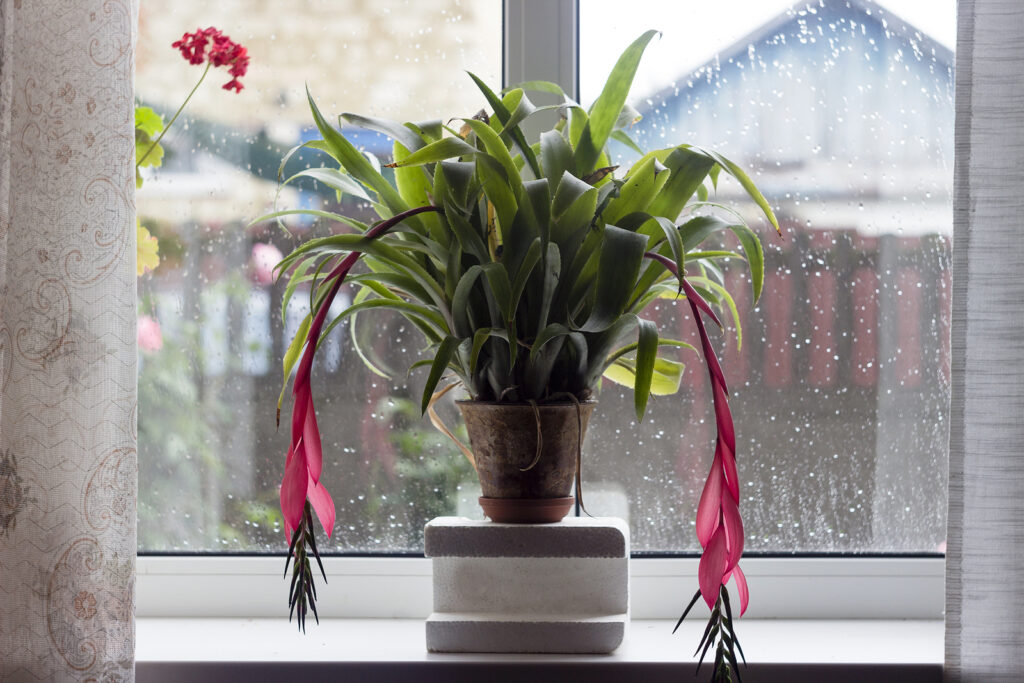
Bromeliad care
- Put bromeliads outdoors in summer.
Bromeliad common problems
- Too much light can cause sunburn on leaves.
- Hard water can cause white stains (salt or lime buildup) on leaves; flush the cups weekly with rainwater to remove the stains.
Bromeliad propagation
- Remove offshoots at the base of plants and repot them. When the offset is several months old remove it with some roots attached and plant it swallowing in a seed-starting compost. Keep it warm until it is well-established.
Bromeliads varieties to grow
Click on the botanical name for detailed growing instructions for these Bromeliads:
- Aechmea spp. and hybrids, commonly called living vase, grow strap-shaped, blue-green leaves marked with silvery bands. Urn plant (A. fasciata) has fat spikes of blue flowers and showy, pink, petal-like bracts. Bright but not direct lights and average household warmth. When flowers fade, new plants develop as side shoots.
- Ananus comosus, the pineapple, has a vase-shaped form with narrow, toothed, gray-green leaves; the flower stalk is topped with a miniature pineapple.
- Billbergia is a striking bromeliad recognized for its tall, vase-like rosette and spectacular, tubular flowers that cascade gracefully, adding vibrant color to both tropical gardens and indoor settings.
- Cryptanthus, commonly referred to as Earth Stars, is a low-growing bromeliad celebrated for its star-shaped rosette of colorful, textured leaves that thrive in low-light conditions, making it a popular choice for indoor gardens and terrariums.
- Dyckia is a resilient bromeliad known for its spiky, architectural foliage and vibrant colors, thriving in arid conditions and ideal for rock gardens or as a striking houseplant.
- Guzmania spp. and hybrids grow in a vase shape with strap-like, arching, green leaves to 18 inches with broad spreading flower heads in brilliant colors. Bright green but not direct light; average household warmth; warmth at 75°F will induce flowering. G. musaica has mottled foliage and orange-yellow spires of flowers.
- Neoregelia spp. and hybrids have somewhat flattened rosettes of green leaves that are red near the bottom of the vase; flowers appear at the center with a blush of color. Needs bright but not direct light; average household warmth.
- Nidularium is a charming bromeliad characterized by its rosette of broad, strap-like leaves and colorful bracts that often bear bright, tubular flowers, making it an attractive choice for gardens and indoor displays.
- Tillandsia cyanea, commonly called air plant, has long, narrow, arching, green leaves and flat, paddle-like plumes of deep pink or red bracts and violet-blue flowers.
- Vriesia splendens, commonly called flaming sword, has vases of brown-banded, green leaves and long, red flower spikes that can grow to 3 feet long. Needs bright but not direct light and average household warmth; warmth at 75°F will induce flowering.
Bromeliads frequently asked questions
Q: What is the correct care for bromeliads?
A: Treat bromeliads like other succulent plants. They like winter temperatures of 55° to 60°F. High temperatures above 75°F may be required to bring plants into flower, but average warmth is satisfactory for foliage or plants in flower. Most bromeliads require a brightly lit spot away from direct sunlight.
Q: What are the best bromeliads for beginners to grow?
A: First try Aechmea and Billergia. A bit more temperamental are Vriesia and Tillandsia.
Q: How do I water bromeliads?
A: Aechmea, Billbergia, and Guzmania need their growing medium just slightly moist; they must have their growing “vases” filled with water all through the growing season. Those without water reservoirs–Cryptanthus, Tillandsia–need an evenly moist growing medium through spring, summer, and fall, with a slight drying during out in winter. Never overwater and ensure there is good drainage.
Q: What is the best potting medium for bromeliads?
A: A half-and-half mixture of shredded osmunda or tree-fern fiber with soil. Also, a handful of pebbles suits most bromeliads. An exception is Cryptanthus, a terrestrial species, which can be grown in standard house plant soil.
Q: How do I feed bromeliads?
A: Mist bromeliads frequently. Feeding through the leaves is the natural method of nutrition, so occasionally use dilute liquid fertilizer instead of water in the sprayer.
Q: Do bromeliads need sunlight to bloom indoors?
A: Bromeliads will do better with some sunlight not only to encourage bloom but also for good leaf color. Much of their beauty is in their colorful foliage.
Q: Is it true that putting an apple in the “vase” of a bromeliad will make it bloom?
A: Yes, the gas given off by the apple apparently stimulates flowering. Cover the plant and apple securely with plastic.

